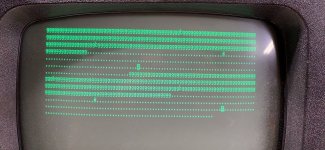waltermixxx
Experienced Member
Hi folks I was wondering if anyone has encountered this issue before.
(First let me start by saying i had a good read through the "CBM8032 What does the start up chirp really mean" thread,
lots of very good stuff in there. ) Okie doke back to my issue.
I am fixing an 8032 Universal board for a friend. When powered up, the computer chirps and reports Commodore Basic 4.0 message along with
the amount of free ram. Here is where the issue is. It says only 50 bytes free. I have had luck in the past fixing ram issues by piggy backing
ram onto existing ram, to locate the bad ram. That trick did not work this time, even with 16 good 4116 rams chips piggy backed. it got me thinking, basic is working, some ram is working, the CRTC is working. What could the issue be? So I loaded up an eprom with the DiagV4 diagnostic rom image (PETTESTE2K – Version04.), turned on the computer and got the image below.
The diagnostics stops on the page 0 and page 1 test it looks like.... it got me thinking:
Could it be the CAS0 or CAS1 signal? I'm thinking: So without proper RAS and CAS signals I think the dynamic ram on the pet bottoms out to 128 bytes of ram. So I am going to scope the ras and cas0 and cas1 lines and see what is there... I'm kinda thinking it's not a ram issue, could be a support chip, either one of the 74LS244's or perhaps the 74LS00 (UD5) I will check what's going into those chips, and what's coming out. The data bus and the address lines in general appear to be good because Rom is being accessed for basic and the video ram is being accessed properly at 8000 (nothing strange on the screen) I'm very new to fixing pets, and sometimes a little bit of knowledge is a dangerous thing. I'm hoping I'm on the right track. the only thing that does not support my theory is the b's in the Pet tester diagnostic result.... hmmmmmmm
I'm hoping I'm on the right track. the only thing that does not support my theory is the b's in the Pet tester diagnostic result.... hmmmmmmm

(First let me start by saying i had a good read through the "CBM8032 What does the start up chirp really mean" thread,
lots of very good stuff in there. ) Okie doke back to my issue.
I am fixing an 8032 Universal board for a friend. When powered up, the computer chirps and reports Commodore Basic 4.0 message along with
the amount of free ram. Here is where the issue is. It says only 50 bytes free. I have had luck in the past fixing ram issues by piggy backing
ram onto existing ram, to locate the bad ram. That trick did not work this time, even with 16 good 4116 rams chips piggy backed. it got me thinking, basic is working, some ram is working, the CRTC is working. What could the issue be? So I loaded up an eprom with the DiagV4 diagnostic rom image (PETTESTE2K – Version04.), turned on the computer and got the image below.
The diagnostics stops on the page 0 and page 1 test it looks like.... it got me thinking:
Could it be the CAS0 or CAS1 signal? I'm thinking: So without proper RAS and CAS signals I think the dynamic ram on the pet bottoms out to 128 bytes of ram. So I am going to scope the ras and cas0 and cas1 lines and see what is there... I'm kinda thinking it's not a ram issue, could be a support chip, either one of the 74LS244's or perhaps the 74LS00 (UD5) I will check what's going into those chips, and what's coming out. The data bus and the address lines in general appear to be good because Rom is being accessed for basic and the video ram is being accessed properly at 8000 (nothing strange on the screen) I'm very new to fixing pets, and sometimes a little bit of knowledge is a dangerous thing.

Last edited:
